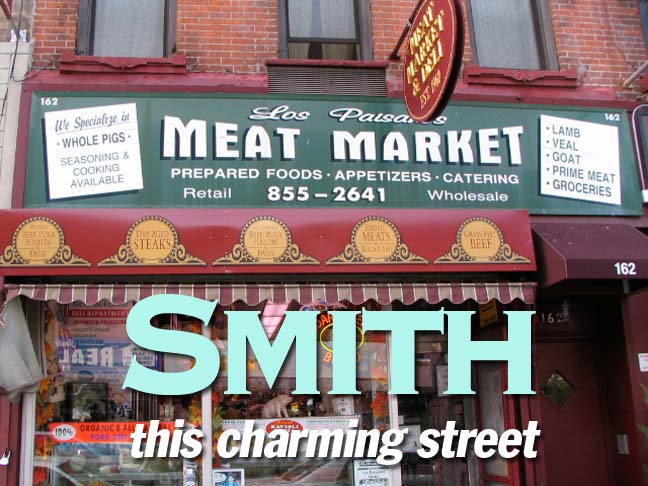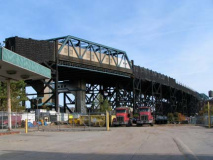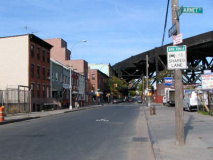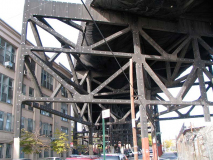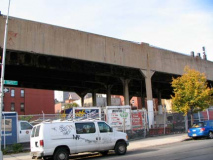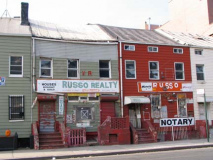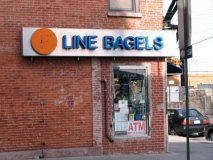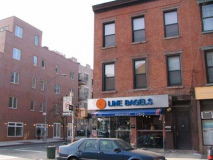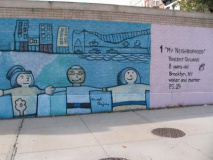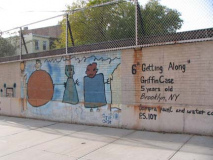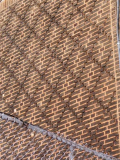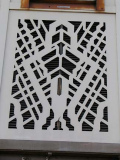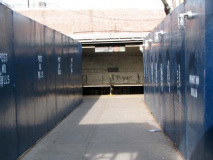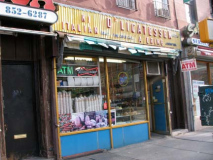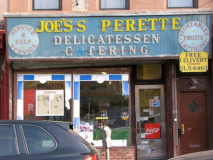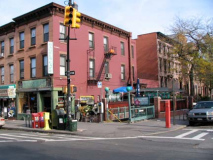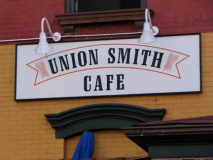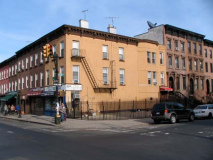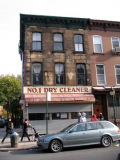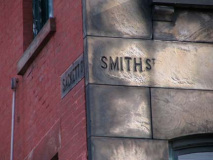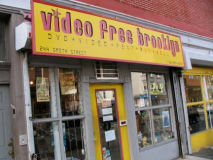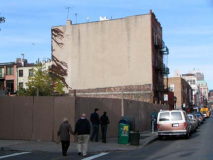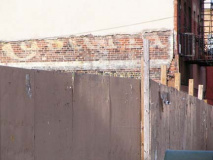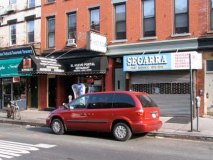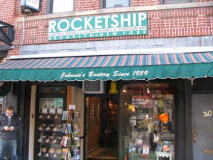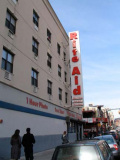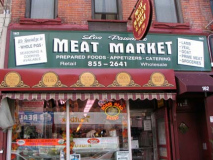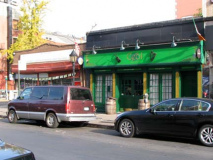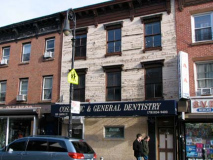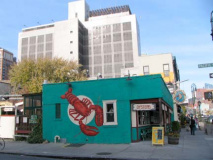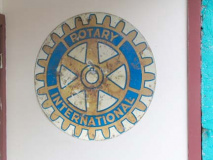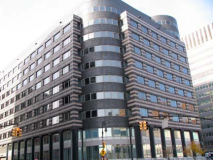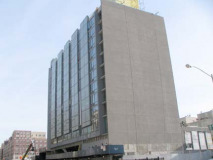I recently got an angry note from a ForgottenFan that, as far as I understood it, excoriated me for not yet making it down to Gerritsen Beach for a FNY page. Fear not, with a few days off coming up during the holidays (recent losses have chastened me into doing a Staycation™ this holiday season) I fully intend to do some exploring in Gerritsen and Marine Parks, Georgetown, Bergen Beach, and other southern Brooklyn locales that the guidebooks ignore. During the fall, though, I did extensive photography in Cobble Hill, Carroll Gardens and Red Hook, hoping to find aspects of these well-chronicled regions that the tour buses always pass by.
I never have enough time to do FNY, but I realize that if I wish for more spare time … I will likely get it.
Smith Street runs from Fulton and Jay Streets southwest all the way to tiny Percival Street alongside the Gowanus Canal. For most of its length it is, along with parallelling Court Street, the commercial spine of Carroll Gardens. It was named for Samuel Smith (1788-1872), who owned considerable acreage in the area (he was also briefly mayor of Brooklyn) and the street, one of Brooklyn’s first paved, was named for him before his death. From the beginning it was a commercial hub and was also lined with taverns catering to dockworkers and longshoremen; the street also became clustered with furniture stores…
For much of the 20th Century, while Court Street was Italian, Smith Street was Latino:
It’s difficult to believe today but oh, for a hundred years or so, Spanish speaking peoples lived throughout South Brooklyn. at first they were Cuban, and from Spain, and then, through the 1960s, largely Puerto Rican — it’s a series of long, interlocking stories for another time and WWIB ain’t pretending to know most of ’em except to note… they are out there, they happened. in the last couple years, in the gold rush to make everything possible appeal to the refined upscale mall sensibilities of the SUV-stroller and chain store ‘hipster’ sets, even the vestiges of the vestiges have mostly been scraped clean of formerly polyglot Smith Street. Who Walk In Brooklyn
What I did was to walk Smith from the Smith-9th Street station north to downtown, while attempting to ferret out the remaining vestiges of Smith’s former role as furniture-store mecca, Hispanic hub and middle-to-lower class boulevard, before it was, er, ah, gentrified (the defining marker in that evolution was the 1997 opening of French bistro Patois amid the bodegas). I deliberately stayed clear of the cutesy and precious gewgaw shops and inns that have opened along the route; I’m not their designated demographic or income level. There’s a liitle bit of classic Smith left.
ABOVE: the IND Smith-9th Street station ascends to a full 90 feet over the street level in order to clear tall-mast ship traffic over the Gowanus Canal; under today’s configurations, it would not have been built nearly so high. In Brooklyn there are, in fact, two West 9th Streets: one between West 8th and West 10th in Gravesend, and this one, named simply because it is a western extension of 9th Street from Smith west to Columbia.
The height of this trestle makes it eminently photographable. The locale has been used for many movie shoots, most memorably Goodfellas.
9/11/01 mural, Smith and Garnet Streets, signed Scott LoBaido:
Scott LoBaido is a self taught artist … diverse in his style, medium, and subject. Most artists stick to one continuous style. Scott loves the challenges of change and diversity. You will see in the gallery his wide range of works, from the surreal and abstract paintings to the pop art of his love for patriotism.
His past is rather colorful and controversial, as he was known for his notorious pro-American activism. With his art as his platform, he has been featured in hundreds of newspapers, TV news programs and radio shows like CNN’s Anderson Cooper, ABC’s World News Tonight (Person of the Week) and FOX’s Bill O’Reilly Show.
Since retiring from his period of provocative, public expressions, Scott has now devoted his time to studio work: painting images of his love for patriotism, as well as the surreal images from the depths of his imagination. The artist has been emerging for some time, and is about to explode on the national scene. Slated for June 2008 is a documentary on patriotism that features Scott and his “Flags Across America” project.
The immense concrete subway trestle has been swathed for the last dozen years or so in canvas after the exterior began deteriorating and breaking off. However the actual concrete cladding can be glimpsed at the approach along Smith Street on the gradual incline. In Park Slope, the IND dips suddenly underground just south of the 4th Avenue station as there is a steeper hill there.
The Russo Realty empire at West 9th and Smith seems to be contracting, with just the red frame building still open. The boxed “x” on the other building means the floor has collapsed and it is dangerous to enter.
Russo Realty is, or was, a real estate empire headed by World War II veteran Vinnie Russo. From FNY’s Lavender Lake:
“Vinnie told me that when he returned from Pearl Harbor in 1947, he went into real estate purchasing buildings all over Cobble Hill. Over the years he’s had a lot of trials and tribulations, which he couldn’t wait to tell me about.
“I took a break to go to the bathroom, which is another work of art. It was a good-sized room with a tiny cot and walls covered with nudie pictures. When I came out, there were more visitors crammed into the tiny office including a huge handsome man wearing a hairdresser’s outfit and makeup.
“The small group talked and laughed and told me they are trying to make a museum out of the place….” Kit Kaplan, 718Brooklyn
(F) Line Bagels, at the NW corner of Smith and West 9th, used to be called F Line Bagels and used the familiar orange bullet F symbol displayed on the R46 cars that ply the subway line. When the shop opened in 2005 it indeed displayed the F on store signage, but the MTA claimed it was appropriating “intellectual property”: In late November, 2005 a judge in Manhattan ordered the bagel store to cover up all transit-related items immediately, and to remove the accessories within 60 days. The store went with backwards F’s for awhile, but apparently has given up the battle. Ironically the Assad brothers, who owned the store, purchased more than $1000 worth of subway memorabilia from the MTA Transit Museum store to decorate the place.
New R143 and R160 cars, gradually becoming a part of the MTA fleet, don’t use the colored bullets on the exteriors at all; they only appear on the strip station indicators on the car interiors.
In the mid-and late 1990s, neighborhood children painted murals on the concrete IND line wall between 2nd and 3rd Places south of the Carroll Street station.
The exterior of the Smith Street substation (containing machinery providing electric power to the trains) dates, along with the rest of the line, to the early 1930s, and contains some prime Art Moderne styling such as decorative metalwork, sanserif lettering, and patterened brickwork.
IND styling (1925-1940) isn’t as celebrated as the earlier Heins and LaFarge Beaux Arts stations from 1904-1908, or even the Squire Vickers “Arts and Crafts” BMT stations that followed them (1908-1928) but this is just as evocative of a bygone age.
Carroll Street IND station, 2nd Place and Smith Street. 360 Smith Street/131 2nd Place is the supposed future home of luxury condo project Oliver House; though land has been cleared out, Carroll Gardens residents pushed for a rezoning that would scale back the height and density of new projects in the area, preventing large, out of context developments. As a result Oliver House developer William Stein is waiting for a ruling from the Board of Standards and Appeals to decide whether the building should be 70 feet tall or scaled down to 50 feet.
The subway exit/entrance, which formerly faced a park, will remain enshrouded in construction fencing until further notice and will likely close temporarily when/if construction gets under way.
Though no one refers to it as Eileen C. Dugan Boulevard, that has been Smith Street’s official co-title since 1999. The 9-term Assemblywoman (1945-1996) served in his district from 1980 until her death in ’96.
Seeing the name on street signs brings a slight pang of nostalgia, since Dugan was first elected while I was attending St. Francis College on Remsen Street.
Following a former trend (that they have since amended — see the Harry Van Arsdale Jr. Blvd./Jewel Avenue whopper here) the DOT here squeezed both names onto single signs, rendering both fairly illegible.
Dueling delis. Only one storefront separates these two classic signs. At first I wondered what a “perette” was. The “UL” exchange on the sign at right stands for ULster.
Gowanus Yacht Club, Smith and President Street, is closed for the season in November; the outdoor beer and hotdog garden is open in spring and summer. Owners Alan Harding and James Mamary have run/designed many restaurants on Smith Street including the aforementioned Patois beginning in 1997 as well as Union Smith Cafe and Trout. Your webmaster went to grade school (g. 1971) with a Victoria Mamary; is there a relation there?
RIGHT: juice bar, formerly Park Lane Florists
Smith Union, meet Union Smith. They really have to get more imaginative with the nomenclature around here.
I haven’t eaten at Union Smith, but not for lack of trying. We showed up around 3 or 4 one day, only to be told it was between lunch and dinner and they wouldn’t be serving till later on. So, we had a drink and bolted to where we could eat.
Any restaurateurs that are ForgottenFans? I have a simple question — not being a gourmet but a gourmand, I’m used to drifing into diners, delis and pizzerias where I can get something to eat all day. What’s with closing the kitchen during the afternoon? I met with this at a place on Cortelyou Road during the summer, too. You’re a restaurant, don’t you have anything lying around in the fridge?
Note the setback at the corner of Union and Smith … they’re there at other corners in the neighborhood, as well (Gowanus Yacht Club is situated in one of these indents). The side streets were plotted with unusually deep plots, making for extra-long front yards. It was surveyed thus by Richard Butts in 1846. The occasionally lush gardens in the front yards give Carroll Gardens its name.
SE corner, Sackett and Smith. Not only has the ancient stone work been kept in the front, the original chiseled street signing is still there. See how the carver not only superscripted the T but also underscored it? They gave a damn about this stuff in the mid 1800s.
Video Free Brooklyn, Smith at Douglass. I like the hand lettered sign, but I have more questions: if a) Brooklyn is video free, why is the store here, or b) are the videos, in fact, free? c) I haven’t been in one of these places in years. Do they still rent VHS? I still have a VCR which will be pried from my cold dead hands. I still tape TV shows.
“You ask too many questions”
You may wonder why I’m taking a photo of the nondescript empty lot and building at Douglass and Smith, but a closer look reveals the bottom of an old Fletcher’s Castoria ad. As this photo on Shorpy reveals, NYC was once awash in Castoria … signs, at least. This was a good one with ornate script, but developers care little for old advertising.
I began to find traces of Smith Street’s recent Hispanic past around Butler Street.
The Rite-Aid at Warren and Smith is a former J. Michaels furniture store, while nearby Rocketship comics still has its old Johnny’s Bootery awning. Michaels, “the friend of the people,” was in business over a century before merging with the Muriel Siebert Financial Corp. in 1996.
Between Wyckoff and Bergen: If you have never been there before, you may not know what really, really fresh meat looks like. And they’ve got it all: beef, pork, poultry and lamb, to the more exotic game like elk and venison. They have grass-fed beef, organic, and high-grade Angus, to the dry (and finely) aged right where you can see it: NY strips, porter houses, t-bones, rib eyes, cowboy steaks and pursuito de parma. And if your thing is sausage, real sausage, just stop reading now and go in because space doesnít permit me to gush over all the different kinds, tastes, and qualities of their lineup. And they do custom orders. Brooklyn Eagle
Your webmaster understands vegetarianism, but I just can’t do it. (Not so in other things; I do not understand how it is possible to run 26 miles, when I can’t run 5 blocks.)
I said I wouldn’t delve into the new Smith Street scene but I will when I enjoy the signage, like on this sign at left. “Ceol” is “music” in Irish. RIGHT: is that an exposed wood frame?
Smith relics: Bayamon Medical Center, Shahid Perfumery.
The Brooklyn House of Detention on Atlantic Avenue looms over Trout, with which Harding, I gather, replaced the unsuccessful Gravy in 2008. I didn’t go in, but I do applaud the preservation and retention of earlier architectural elements, as well as signage (Rotary Club) from a previous incarnation.
The jail is empty at present, but despite community objection, the city does plan to reopen it as a facility housing approximately 1500 inmates. Plans for retail on the ground floor (yes, retail) have been dropped for now.
LEFT: The ‘new’ or newer MTA headquarters, designed in 1989 by Chicago architect Helmut Jahn, fills the block between Schermerhorn, Smith, Livingston Streets and Boerum Place. Gray isn’t my color but I like the alternating color bands of light and dark brick. RIGHT: Detention chic? Schermerhorn, once lined with parking lots and nondescript back office buildings, has a flock of high-rise luxury buildings sprouting on it. This one seems to be trying to imitate the nearby jail, at least on the exterior.
As Smith Street ends (really begins) at Fulton Street there’s one more Easter egg, a pair of Schrafft’s logos above the 2nd story windows at 1 Smith Street.
Schrafft’s was founded by William F. Schrafft in 1861 in Charlestown, Massachusetts:
Schrafft’s was known for wholesome, all-American fare, served by fresh-faced Irish waitresses. Mothers and children ate there; so did movie stars. Schrafft’s restaurants were located in high-end shopping districts, like Fulton Street in Downtown Brooklyn.
But times changed, Fulton Street changed, and Schrafft’s did, too. By 1968 they seemed quaint, almost dowdy. They hired Andy Warhol, of all people, to give them a snazzy new with-it image, and remodeled to emphasize their bars to snag the younger clientele. McBrooklyn
Schrafft’s was purchased by the Riese Organization in 1978, the company that brings you T.G.I. Friday’s (which until 2007 occupied the old Gage and Tollner landmarked space on Fulton Street in Brooklyn) and soon after their many locations closed. “Schrafft’s” has since been reactivated as an ice cream brand.
NYCNosh: In Search of Schrafft’s

